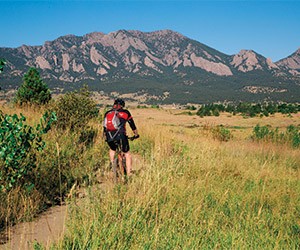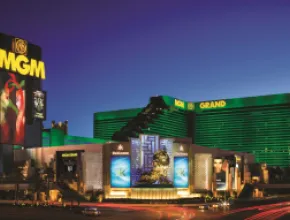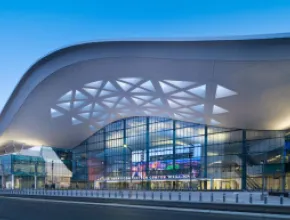Denver and Boulder naturally top the list of cities that can provide a “green” experience for meetings. Set at the base of Colorado’s Rocky Mountains, the two destinations are known as leaders in sustainability in areas ranging from green roofs to locavore restaurants to environmentally friendly hotel initiatives.
This attention to being green is evident from the time visitors arrive at the main airport for the region, Denver International Airport. The facility has set its own standards for environmental performance and energy efficiency, and is now connected via the Regional Transportation District (RTD) rail service to a restored Denver Union Station, which offers a variety of event space of its own.
Denver
In downtown Denver, meeting-goers will find a mild climate, 300 days of sunshine and a compact walkable area, according to Tiffany Eck, associate director of convention services for Visit Denver, the CVB.
“Denver’s walkability lends itself well to allowing meeting professionals and attendees to explore the city,” Eck said.
The April 2016 arrival of the RTD’s University of Colorado A line makes it even more time- and cost-efficient to get to the downtown area from the airport, clocking in at under 40 minutes.
Light rail connections link downtown hotels like the Westin Denver Downtown and Sheraton Denver Downtown Hotel. Also convenient are properties closer to the airport, like the Hyatt Regency Aurora/Denver Conference Center, which offers 36,000 square feet of meeting space, including an 8,000-square-foot IACC-certified conference center.
“This puts us at a competitive advantage in terms of sustainability,” Eck said. “In theory, no attendees would have any need for a car.”
Eck said that requests from meeting planners for green initiatives have been a common theme. The CVB is dedicated to serving as a resource and provides a Green Vendor Directory, which allows visitors to sort businesses by certification type and practice and gathers statistics on sustainability issues for 20 downtown hotels.
The City of Denver recently passed a green roof initiative, where buildings of more than 25,000 square feet must dedicate a percentage of their roof to green, vegetative space. The city-owned Colorado Convention Center has also made sustainability a priority.
“The Colorado Convention Center is a premier green meeting space,” Eck said. “They have their own dedicated sustainable program manager and their own Blue Bear Farm, from which the caterers create much of the food for meetings.”
Lindsey Arell serves as the sustainable program manager at the Colorado Convention Center and also works with a number of other venues throughout the city, including the popular Red Rocks Park and Amphitheatre. Not only does Arell work with the facilities internally on issues such as energy, waste, water and air quality, she helps groups meeting at the center with their own sustainability initiatives.
“We can provide them with metrics,” Arell said. “Meeting planners often don’t understand how to measure their impact and we can provide a sustainability report after the event that they can turn it into action moving forward.”
In turn, there are groups that have helped the center become greener.
“In 2006, the Greenbuild International Conference asked for a recycling program and we’ve had it ever since,” Arell said. “Composting was requested in 2008 for the Democratic National Convention. That program has stayed in place, and in 2017 the center composted 467,240 pounds of food waste.”
The center is LEED Gold-certified and about to undergo recertification, according to Arell. It’s also about to undergo a significant expansion. Approved by voters in 2015, the project is in the design stage but is expected to feature 80,000 square feet of meeting space and 120,000 square feet of prefunction and service space, all of which will be located on the roof of the existing building. Also included will be a 50,000-square-foot outdoor terrace with panoramic views.
“Our clients are most excited about the size of the meeting space and the expansion’s location on top of the Colorado Convention Center with stunning, sweeping views of both the city and the Rocky Mountains,” said Rachel Benedick, vice-president of sales and services for Visit Denver.
Denver has also seen growth in new green dining options, including local marketplaces, chef-driven restaurants, brewhouses and hyper-local fine dining, according to Eck.
“We’re hosting Season 15 of the renowned culinary show, Top Chef, and in July 2017 we became home to the first-ever U.S. Slow Food Nations, an offshoot of Terra Madre (slow food event) in Turin, Italy, which will return in summer 2018.”
Boulder
Home to the University of Colorado and a vibrant tech and science scene, and with the spectacular Flatirons serving as a backdrop, Boulder is a city that lends itself to modern thinking and environment sustainability. And its offerings for meeting planners are only expected to grow.
“With 500 new hotel rooms coming online, it’s never been a better time to book in Boulder,” said Andrew Heidt, director of group sales for the Boulder CVB. “Brand-new hotel options in addition to the classics—many recently renovated—offer new options to groups that may not have looked at Boulder in the past.”
The historic Hotel Boulderado, which opened in 1909, recently completed an extensive renovation that included a number of green elements, according to Jayna Kline, senior interior designer at Rowland+Broughton, which designed the hotel’s renovation.
“The architecture and interior design team aspired to celebrate and respect its significant history, while making it feel current and inviting,” Kline said.
Green elements included LED light fixtures in the meeting rooms, zero VOC paint and CRI Green Label Plus carpet and area rugs.
Hotels with green programs include the St Julian Hotel & Spa, which has a committee that works closely with the city toward a goal of zero waste, and the Best Western Plus Boulder, which also has a “green” team and was the first hotel in Colorado to be named a “green leader” by TripAdvisor.
Boulder, which is also featured in the current season of Top Chef, has been called “America’s Foodiest Town” by Bon Appetit magazine. Heidt mentioned the mountain feel of the city as being one of the reasons for its burgeoning food scene.
“Chefs who could cook anywhere choose to be here in Boulder for its acres of fresh ingredients and love of the outdoors,” Heidt said. “Who doesn’t want to go on a hike before entering a hot kitchen?”
The Boulder County Farm Trail offers opportunities for attendees to spend the day learning about organic farming practices followed by dinner on the farm. Groups can also hold events at the Black Cat, which has a private dining area for groups and prepares nearly everything from its own farm. Another option is the Boulder Library, with a cafe run by the Boulder Farmers Market.
The LEED-certified Jewish Community Center opened in 2016 in an area of the city surrounded by farms. The center offers a variety of meeting space that includes a 4,000-square-foot hall with windows offering mountain views. Galvanize Boulder also opened in 2016 with meeting spaces in a building pursuing LEED Platinum status.
The University of Colorado offers a variety of spaces for groups, including those at Folsom Field, which was the first “zero waste” stadium in the NCAA and features dramatic mountain views. Additional properties with spectacular views include Omni Interlocken Hotel, located between Boulder and Denver, and the YMCA of the Rockies, located north of Boulder at the gateway to Rocky Mountain National Park. It offers a variety of activities such as guided hikes and ziplining to take advantage of the natural surroundings.
CVB Contact Information
Boulder CVB
303.442.2911
Visit Denver, the Convention & Visitors Bureau
303.892.1112






